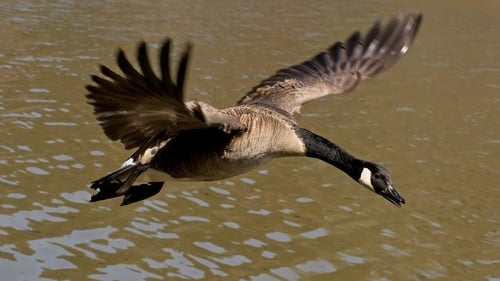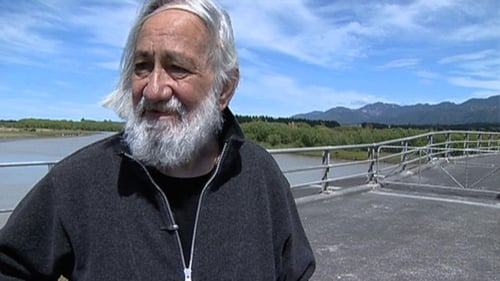Ozogoche (2023)
장르 : 다큐멘터리
상영시간 : 1시간 17분
연출 : Joe Houlberg
각본 : Andrés Cornejo Pinto
시놉시스
Cuviví is the Ecuadorean indigenous name for the upland sandpiper, a wading bird that has special significance for the communities living around the Ozogoche lakes in the middle of the Andes. Each year, these birds migrate south from North America. Around September they pass the Ozogoche lakes, where large numbers then “commit suicide,” plunging from great heights into the ice-cold water. A girl lives near the lake. Her uncle lives in the US, and she might be heading there herself. In the meantime, she awaits the arrival of the cuvivís, few of which have appeared in recent years. The lakes are drying up.

철따라 무리지어 이동하는 새들의 여행을 담은 다큐멘터리 영화로 96년 '마이크로코스모스'를 프로듀싱했던 자크 페랭의 감독 데뷔작이다. '마이크로코스모스'를 통해 풀숲에서 나누는 달팽이의 사랑, 작열하는 태양 아래 행진하는 개미의 생존 투쟁, 달밤에 울려 퍼지는 경이로운 풀벌레 소리를 보여줌으로써 우리의 무딘 눈과 귀를 자극했던 페랭은 '철새 Le Peuple Migrateur'에서 하늘 위로 카메라를 옮겼다. “새들의 눈으로 바라본 세상을 그대로 보여주고 싶었다”는 감독의 의도대로 카메라는 철새의 무리 안에 최대한 밀착해 인간의 눈으로는 볼 수 없었던 아름다운 영상들을 펼쳐 보인다. 광활한 숲이나 두텁게 드리운 구름층 위로 유유히 날아가는 새떼를 담은 파노라믹한 광경을 볼 때는 탄성이 저절로 새어 나오고, 근접 촬영한 새들의 날개짓을 보면서 두 팔이 날개라도 된 것처럼 흔들어대는 관객들이 있을 만큼 생생한 운동감도 전해준다. 3년여에 걸친 촬영기간 동안 유럽, 아프리카, 미국, 극동 아시아 지역 등 전세계 36개국 76개 지역을 돌며 35종에 이르는 철새들의 여행을 담아낸 이 장대한 ‘야생 교향곡’을 위해 수백 명의 대규모 스탭이 동원됐고 총 2억 프랑 (한화 약 350억 원)의 제작비가 투입됐다. 자크 페랭은 60년대부터 배우로 활동하기 시작해 자크 드미 감독의 '로슈포르의 연인들', 코스타 가브라스 감독의 등에 출연한 바 있는 배우 출신 감독. '마이크로코스모스'로 세자르 영화제에서 제작상을 수상한 그는 ‘97년 '히말라야, 추장의 어린 시절' 등 자연과 인간을 다룬 다큐멘터리로 관심을 옮겨가고 있다. 프랑스 영화계에서는 자연의 아름다움을 시적인 화면으로 담아내는 것에 그치지 않고 카메라를 매개로 자연과 인간의 교감을 이루어내면서 문명에 대한 성찰을 녹여내고 있다는 점을 '철새 Le Peuple Migrateur'의 가장 큰 미덕으로 꼽고 있다.

Thirty years ago, a rubber company enslaved a group of Asháninka people, manipulating them into tapping the trees in the lush borderland between Peru and Brazil. The company was expelled by a coalition of Indigenous and non-Indigenous people, led by one mixed race couple. Now the adult children of this marriage combat political corruption and ongoing environmental disaster.

50 years on, the Aboriginal Tent Embassy is the oldest continuing protest occupation site in the world. Taking a fresh lens this is a bold dive into a year of protest and revolutionary change for First Nations people.

Men and women of the !Kung people in Ojokhoe, Namibia perform healing dances by firelight. First we see men perform the giraffe dance, and then women perform the !gwa dance.

The wild beauty of the Bella Coola Valley blends with vivid watercolor animation illuminating the role of the Nuxalk oral tradition and the intersection of story, place and culture.

A group of people bows down as a ritual for religious ceremonies. This community shares a belief named Sapta Drama, one of the native religions in Indonesia that uses bowing down as a worshiping medium.

In a remote Peruvian city, lives Honorata Vilca, an illiterate woman of Quechua descent who sells candies more than 20 years ago, with the rain will cry to the sky itself.

With narration from Paul McGann, this ground-breaking film sets out to solve one of nature's mysterious phenomena: the Bewick swan's dramatic decline. A pioneering group of scientists and conservationists sets out to discover why we have lost nearly half the Bewick population in the last twenty years. Every year, these majestic birds make one of the world's toughest migrations, across perilous land, sea and skies. Somewhere between the harsh Tundra landscape and the south of England lies the key to their disappearance. We join extreme sportswoman Sacha Dench and award-winning wildlife cameraman Benjamin Sadd, as they follow the swans over 7,000 km, on a journey that pushes both humans and swans to the limits of their endurance. Cutting-edge tracking techonology and innovative filming techniques give privileged insight into the birds' hidden world, providing stunning aerial views and the personal stories of swans, Charlotte, Daisy-Clarke and Leho.

A botanical expedition in Ecuador's Amazon becomes a medium for an indigenous Huaorani community to remember the genocidal colonization it suffered in the 1960s. Meanwhile, a group of ecologists from the capital tries to stop oil exploitation in the last remaining forests where the isolated Huaoranis still live, who to this day refuse to come into contact with civilization.

Manifesto of the Pataxó tribe, with the testimony of the chief José Guajajara, in front of the Monument to Estácio de Sá, where the Tamoios massacre took place in 1567, on the coincident day that celebrates the foundation of the city of Rio de Janeiro, 20 January.

The imagination of history in Ecuador never thought that oil, “its redeeming hope”, discovered in the Lago Agrio No. 1 well, was going to mean the beginning of the worst environmental catastrophe on the planet. Thirty years of operation and exploitation of the Texaco company, forever transformed the rivers and estuaries, the forests and the life of the indigenous communities in the northern Amazon of Ecuador.

The Shipibo-Konibo people of Peruvian Amazon decorate their pottery, jewelry, textiles, and body art with complex geometric patterns called kené. These patterns also have corresponding songs, called icaros, which are integral to the Shipibo way of life. This documentary explores these unique art forms, and one Shipibo family's efforts to safeguard the tradition.

Barry Barclay was a New Zealand/Aotearoa director of documentaries and feature films. He is regarded as one of the world's first, and very influential, Indigenous film makers. The film The Camera on The Shore is a feature length introduction to Barry, and to his film making.

This documentary rescues the valuable work of Martha Colmenares, an indigenous woman from the Zapotec highlands, who in the 1980s filmed the life and customs of her own community, becoming a pioneer of indigenous documentaries. And for the first time, her forgotten story, for forty years, will no longer be invisible.

TOKYO Ainu features the Ainu, an indigenous people of Japan, living in Greater Tokyo (Tokyo and its surrounding areas), who are and actively in promoting their traditional culture in a metropolitan environment away from their traditional homeland, Hokkaido. Shedding a common assumption that all Ainu live in Hokkaido, the film captures the feelings, thoughts and aspirations of Ainu people that who try to follow the Ainu way no matter where they live.

Shot during three seasons, Kenuajuak's documentary tenderly portrays village life and the elements that forge the character of his people: their history, the great open spaces and their unflagging humour. Though Kenuajuak appreciates the amenities of southern civilization that have made their way north, he remains attached to the traditional way of life and the land: its vast tundra, the sea teeming with Arctic char, the sky full of Canada geese. My Village in Nunavik is an unsentimental film by a young Inuk who is open to the outside world but clearly loves his village. With subtitles.

In a dark, ambiguous environment, minuscule particles drift slowly before the lens. The image focuses to reveal spruce trees and tall pines, while Innu voices tell us the story of this territory, this flooded forest. Muffled percussive sounds gradually become louder, suggesting the presence of a hydroelectric dam. The submerged trees gradually transform into firebrands as whispers bring back the stories of this forest.

This documentary started as part of a photography project about the indigenous Ainu population in northern Japan, portraying people from tightly knit communities. They feel deeply connected by their culture and tradition. With gorgeous pictures, the directors explore how different generations of Ainu reflect on their identity after centuries of oppression.









